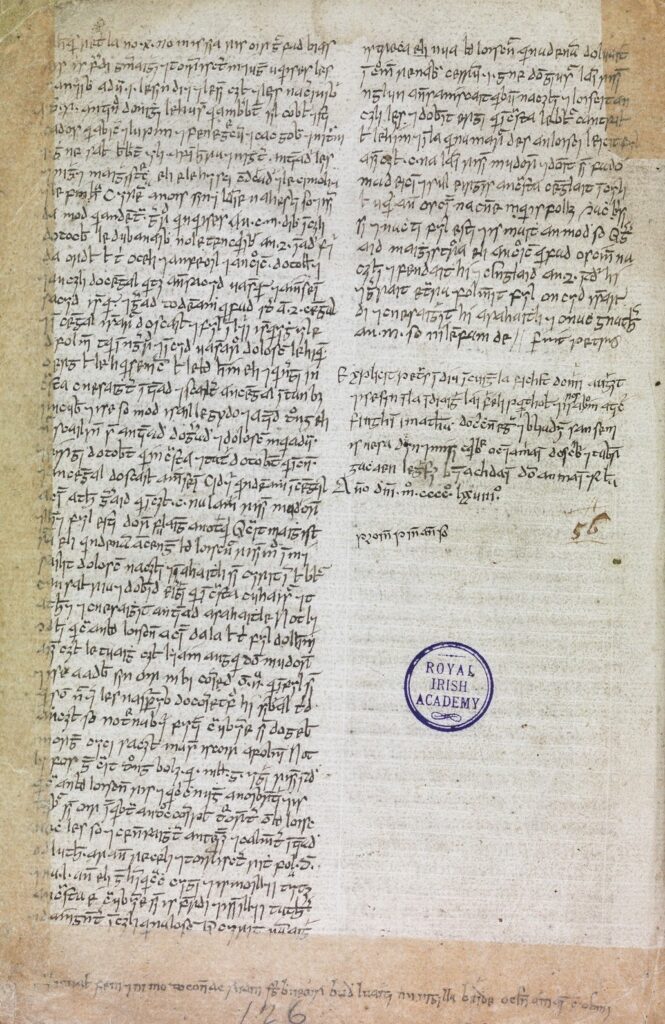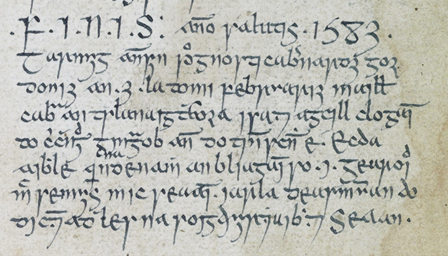Dublin, Royal Irish Academy MS 24 P 15 (444)
Siobhán Barrett

Figure 1: Dublin, Royal Irish Academy MS 24 P 15, p. 126: The end of a tract on surgery by Petrus de Argellata followed by the scribe’s signature and the date and place of writing (image courtesy of Irish Script on Screen)
This manuscript is the work of two scribes working in the south of Ireland in two different locations and in two different centuries. The first of these is Cairbre Ó Cennamháin, writing in 1478 at Ros Broin, in the parish of Schull, on the Mizen Peninsula in Co. Cork. This first section of the manuscript contains an Irish translation of the tract on surgery, De Chirurgia, by Petrus de Argellata, a fifteenth-century Italian academic and physician. There are also several short texts on various subjects including Materia Medica, names of diseases and the administration of medicine in different seasons. At the end of the De Chirurgia the scribe has inserted a colophon naming the location of writing and stating that he is in the house of ‘Finghin i Mathghamhna’, evidently the lord of this name from south-west Cork who produced a translation of the Book of John Mandeville at Ros Broin in 1475, and who was described in the Annals of the Four Masters, at his death in 1496, as ‘a wise man, learned in the Latin and English languages’. A further colophon in the bottom margin of p. 126 in RIA MS 24 P 15 remarks upon the speed of writing of a scribe called ‘In Giolla Buidhe Ó Cennamháin’ but apart from the surname, the connection between the two scribes and this manuscript is unclear. Another Cairbre Ó Cennabháin was writing about a century later (around the mid-sixteenth century) in the west of Ireland and contributed to at least two other manuscripts, London, British Library MS Add. 15582 (see our Manuscript of the Month entry for June 2025) and Edinburgh University Library MS La.III.21, also known as ‘The McBeath Gaelic Medical Manuscript’ (see our Manuscript of the Month entry for March 2025).

Figure 2: Dublin, Royal Irish Academy MS 24 P 15, p. 193: the end of Bernard of Gordon’s Book of Prognostics along with the date and the record of the death of Gerald Fitzgerald, 15th Earl of Desmond (image courtesy of Irish Script on Screen)
The second scribe of RIA MS 24 P 15 is Corc Ó Cadhla and in 1583–4, over a century later than the first scribe, he made his contribution to this manuscript in Cill Chlogáin, in the parish of Templetown, on the Hook Peninsula in Co. Wexford. This second section contains incomplete Irish translations of two works by the Montpellier physician, Bernard of Gordon: Decem ingenia curandorum morborum (‘Ten Methods of Healing Diseases’) and the Liber pronosticorum (‘Book of Prognostics’). On p. 144, a later hand adds the information that this Corc Óg is ‘mac Emuind mic Cuirc’. An interesting inclusion is a note on p. 193 recording of the death in 1583 of Gearoid mac Semuis mic Seaain iarla Deasmuman (Gerald Fitzgerald, 15th Earl of Desmond). The RIA cataloguer states that comparison with the hand of RIA MS 24 P 14, a copy of Bernard of Gordon’s Lilium Medicinae dated to 1577–8, shows that the scribe of both of these manuscripts is Corc Óg Ó Cadhla, who was then working in locations in Co Kilkenny (‘Teagh na Ronna’, probably Tinnaranny, and ‘Grainseach na Manach’, possibly Gráig na Manach), as well as in Lios Áilleacáin, Co Carlow.
Further Reading:
- Demaitre, Luke (1980), Doctor Bernard de Gordon: Professor and Practitioner (Toronto: Pontifical Institute of Mediaeval Studies)
- Faerber, Beatrix (2021), ‘A Text Preserved at the Aghmacart Medical School: Bernard de Gordon’s De Prognosticis, Book II, 9’, Ossory, Laois and Leinster 7: 100-22
- McCormack, Anthony (2009), ‘Fitzgerald, Gerald Fitz James’, Dictionary of Irish Biography (Dublin: Royal Irish Academy) (Accessed 13 August 2025)
- Ó Muraíle, Nollaig (2016), ‘The Hereditary Medical Families of Gaelic Ireland’, in Rosa Anglica: Reassessments, ed. by Liam P. Ó Murchú, Irish Texts Society Subsidiary Series 28 (London: Irish Texts Society), pp. 85–113
- Stokes, Whitley, ed. (1899), ‘The Gaelic Maundeville’, Zeitschrift für Celtische Philologie 2: 1–63, 226–301
- Walsh, Paul (1933) ‘Corc Óg Ó Cadhla’, in his Gleanings from Irish Manuscripts (Dublin: At the Sign of the Three Candles), pp 153–81